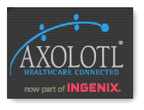I try to keep track of mergers and acquisitions here and the partner Axolotl was purchased by Ingenix in August of 2010, about a year ago, so when you hear of insurers buying up technology companies here’s one and where bottom line revenues end up contributing to for profit insurers. 
Ingenix Acquires Health Information Exchange Services/EHR Provider Axolotl-United Health Group Behemoth Continues to Grow–Subsidiary Watch
Here’s another post from the past that gives a little more background on the HIE and business intelligence algorithms used by United subsidiaries.
Axolotl (A Subsidiary of Ingenix) Creates Reporting and Analytics Solution for Health Information Exchanges–Algorithms for HIE–Business Intelligence -Subsidiary Watch
In addition other subsidiaries sell electronic medical records as well and Care Tracker has been around for a number of years, sold by Ingenix, now under the Optum name.
ClickFreeMD Selling Software EHR, Practice Management Bundled Records Solution–Emphasis on AMA Endorsement And Software “Powered” by Ingenix–Tethered or Untethered
At a cost of $250 per patient per month that adds up to some additional income and yes it is less expensive than visits to the ER room if that can be avoided. If this ends up being a workable solution with proper implementation for a national model, that’s a lot of profit for the subsidiary to add to the corporate bottom line too. Buffalo has has their IT issues reflected too in this story from a year ago where it was found that the City paid over $2 million in premiums for dead city employees and from what I understand, they were having to go to court to get it back? I’m sure all the folks being monitored though are not in that group. I’m just curios too as to who all really has access to the data as analytics are are part of the deal here as that’s the way it works out there today with everyone wanting data.
City of Buffalo Has Paid Over $2 Million to Provide Health Insurance for Hundreds of Dead People-Some as Many as 4 Years
I’m just curios too as to who all really has access to the data as analytics I’m sure are  part of the deal here as that’s the way it works out there today with everyone wanting data. Another division of United sells prescription data for underwriting and other purposes.
part of the deal here as that’s the way it works out there today with everyone wanting data. Another division of United sells prescription data for underwriting and other purposes.
The RHIO didn’t want to be in the monitoring business though so it appears this is where the technology subsidiaries of United came in to play here. The article said there was some resistance but again if they are United approved MDs and have had any recent cuts, then that could maybe stand to reason for some of it and I don’t know how many United policy holders are in this part of New York. BD
BUFFALO, NY – One hundred patients with diabetes have signed up for a telemonitoring pilot spearheaded by HEALTHeLINK, the regional health information organization (RHIO) serving Western New York State. The nonprofit’s innovative approach to telemonitoring could serve as a model for the rest of the nation, according to Todd Norris, Western New York Beacon Project Director.
HEALTHeLINK is one of the 17 Beacon Communities tasked by the Office of the National Coordinator to positively impact quality, cost and population health through the use of healthcare IT. The RHIO is focusing on several initiatives to "move the needle in a positive direction" for diabetes care management, which is its specific goal under the Beacon Community Program. With more than 60,000 diabetic patients under the care of 250 healthcare providers, Western New York has one of the largest diabetic populations per capita in the country, Norris said. The telemonitoring pilot, which will accommodate 150 patients, is one of 12 interventions the RHIO is deploying for diabetic care.
Blood pressure readings and other vital signs pertinent to diabetic management are downloaded from mobile devices and transmitted to healthcare providers in the form of alerts through HEALTHeLINK's health information exchange platform, which is powered by OptumInsight, formerly Axolotl. The RHIO, however, has adjusted the traditional model to address known barriers to telemonitoring adoption.
The cost is approximately $250 per patient per month. Norris pointed out that the elimination of one emergency department visit per patient pays for the program and also contributes to better health of the diabetic population. With economies of scale, the cost per patient per month for 40,000 patients would be $150 per month. At this level, Norris said, "You're going to see lively acceptance."
Tidak ada komentar:
Posting Komentar